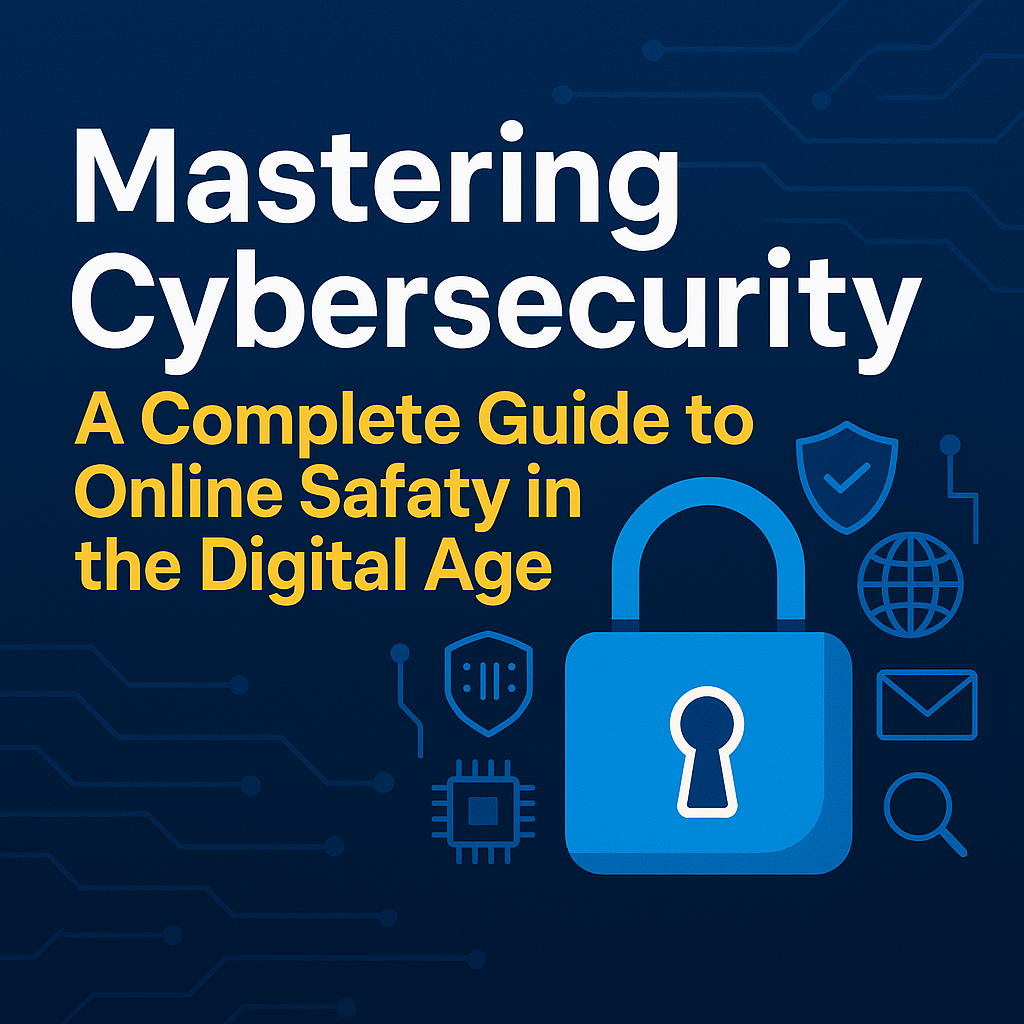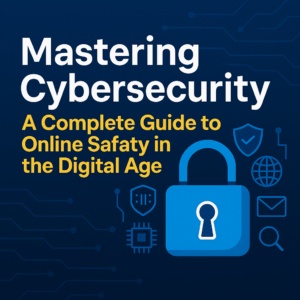Mastering Cybersecurity: A Complete Guide to Online Safety in the Digital Age

The Increasing Threats of Online Security Require Basic Steps to Remain Safe
The modern age of digital connectivity has established new heights of life connections through the widespread internet. Online banking as well as shopping combined with social interaction and work and healthcare delivery depend entirely on the internet. Internet connectivity provides advantages but simultaneously allows Internet dangers to multiply. The practice of protecting digital systems and networks alongside data from online attacks through cybersecurity has reached maximum importance today.
The complete manual discusses digital world threats alongside cybersecurity value and attack types and protection methods and emerging cyber defense patterns.
Table of Contents
Introduction to Cybersecurity
Numerous corporations maintain an obligation to protect their customer data.
Types of Cyber Threats
Cybersecurity for Individuals
Cybersecurity for Businesses
Through encryption VPN (Virtual Private Network) creates secure connections for data.
A data breach is possible through opening phishing emails by mistake.
The laws established for cyber security aim to make online fraud hacking and data theft illegal activities.
Zero Trust security models are currently being implemented on a large-scale basis.
Final Thoughts
1. Introduction to Cybersecurity
Cybersecurity functions as the field that protects electronic systems and networks from harmful assaults alongside defending computers, servers, mobile devices along with various data from such attacks.. It’s also known as information technology security or electronic information security.
Online threats have been intensifying each day.. The field now includes the installation of laptop antivirus alongside enterprise firewall deployment and artificial intelligence monitoring systems because of its increasing significance.
2. Theft of data followed by misuse becomes possible through hackers.
The need for cybersecurity exceeds the realm of optionality because it has become mandatory. Every 39 seconds, a hacker attacks a system. There are no limits to who can become a victim of online theft as both individuals posting photos publicly and multinational corporations remain at risk.
The Cost of Cybercrime
The cybersecurity research division at Cybersecurity Ventures predicts that yearly cybercrime expenses will reach $10.5 trillion in 2025. These costs come from:
Data breaches
Ransomware attacks
Business disruption
Legal costs
Reputational damage
Global Digital Shift
Staff members sharing more files and information become frequent during their home office activities. The digital information we create is at risk of being intercepted unauthorized parties who can manipulate or steal it.
3. Types of Cyber Threats
Efforts to defend against cyber threats become more successful through knowledge of their specific types.
1. Phishing Attacks
Users often fall victim to phishers when they disclose sensitive details such as passwords and credit card numbers through fake electronic communication channels.
2. Ransomware
The goal of ransomware is to disable access to data through encryption until its operators receive monetary compensation. The ransomware family includes two main examples such as WannaCry alongside REvil.
3. Malware
Malware refers to malicious software that comprises viruses worms Trojans and spyware which cause harm to disrupt devices.
4.Through the DoS attack an attacker sends excessive network traffic to the target server or network.
These infections shakeup the operations of computer networks and websites by overwhelming them with traffic until they shut down completely.
5. A hacker breaks into the middle of two logged-in systems through their communication channel.
Hackers obtain and modify data by seizing electronic messages between two participating parties.
6. Zero-Day Exploits
Before developers deliver their solution organizations focus on finding security flaws that exist in software.
4. Cybersecurity for Individuals
1. Use Strong Passwords
It is essential not to choose passwords that include trivial sequences like “123456” or “password.” Create passwords containing combination of letters, numbers and symbols to enhance security. Consider a password manager.
2. The system becomes harder to breach for unauthorized logon attempts.
Security grows stronger through 2FA which needs users to authenticate with two verification methods.
3. Be extremely cautious about emails along with their clickable links.
Do not trust emails or their links from unknown senders while also rejecting attachments from unknown sources.
4. Keep Software Updated
Security vulnerability patches are included among the content of each update release.
5. The software detects dangerous programs then removes them.
The tools scan systems for harmful software while also eliminating detected threats.
6. Secure Your Wi-Fi
You should use powerful passwords together with the encryption standards of WPA3.
7. Regular Data Backups
You should make duplicate copies of your files stored either on cloud storage or external hard drives to use when recovering from ransomware attacks or hardware malfunction.
5. Cybersecurity for Businesses
All business organizations regardless of their size deal with essential cybersecurity issues.
1. Conduct Risk Assessments
Detect weaknesses that affect systems along with operational methods.
2.The policy instructs Ye policy employees about safe usage of their systems.
The organization needs to create rules which specify data management processes alongside user permission systems and emergency incident reaction plans.
3. Employee Training
The workforce requires training to identify phishing attempts while using safe practices and threatening situations should be reported.
4. Firewalls together with Intrusion Detection Systems should be implemented
A firewall system functions to stop unwanted system entry while intrusion detection systems track abnormal behavior on networks.
5. Encrypt Sensitive Data
All sensitive information must receive encryption when both being transmitted and stored.y.
6. The system performs a full security check as part of regular system audit processes.
The system protection measures need testing through simulated attacks during evaluation procedures.
6. The tools of a system provide defense against online threats.
Tools and technologies serve multiple functions which boost cybersecurity systems.
1. Antivirus Software
The security solution performs automatic detection of harmful applications before their removal from devices.
2. Firewalls
Establish a system to monitor all traffic moving both inside and outside the corporate network boundaries.
3. The data of VPN users receives encryption from their system.
Internet connections should be encrypted along with IP addresses masked.
4. SIEM (Security Information and Event Management)
The system acquires data from multiple information points to identify security threats.
5. EDR functions as an elevated cybersecurity instrument.
Real-time monitoring combined with endpoint response capabilities form a single solution through its system.
6. Artificial Intelligence (AI)
The detection of irregularities along with predictions of security breaches occurs more efficiently through AI than human capabilities.
7. Human beings comprise the most essential component of cybersecurity.
The level of technology security directly depends on human user practices.
1. Social Engineering
The practice of manipulating people to both execute behaviors and share confidential information constitutes this deception.
2. Insider Threats
The actions of workers who are both harmful on purpose and careless present a major risk to organizations.
3. Awareness Training
All organizations need to make mandatory and ongoing cybersecurity awareness training programs.
8. The law bans criminal activities that include online fraud and hacking alongside identity theft in the digital world.
Multiple governments across the world have implemented legal restrictions and governing rules to building up cybersecurity measures.
1. The data protection law GDPR operates throughout the territory of the European Union (EU).
The system permits entry only to authorized users.
2. The United States established HIPAA as a law through the introduction in 1996.
Protects medical information.
3. The purpose of CCPA law exists to protect personal data of consumers.
Gives California residents control over personal data.
4. IT Act 2000 (India)
The law gives recognition to electronic data interchange transactions which are performed legally.
The law mandates compliance while at the same time creating trust in customers.
9. Cyber threats are continuously becoming newer and more advanced in nature.
The field of cybersecurity will transform because of developing technological progress.
1. AI and Machine Learning
Threat detection will become more efficient while responses will automatically activate and the system will generate attack predictions.
2. Zero Trust Architecture
Before validation occurs all devices and users maintain an untrusted status.
3. Quantum Cryptography
The science has the potential to transform encryption provided it achieves absolute unbreakability.
4. Cloud Security
Cloud infrastructure security stands as an essential priority because many organizations direct service operations toward cloud-based platforms.
5. Cybersecurity Mesh
The new security system promotes tool collaboration through its modern architectural approach.
10. Final Thoughts
All users should establish both robust password creation and secure online practices. Every size organization from single individuals faces actual and rising risks from threats in the online environment. Online dangers can be prevented through proactive steps and maintaining security awareness as well as continuous promotion of security-minded cultural practices.
New technological developments require the development of equivalent protection strategies. Online security demands persistent maintenance that combines training with monitored vigilance and ready changes for remaining safeguarded. The information about strategies together with threat awareness provided throughout this document helps you establish security in the digital domain.



